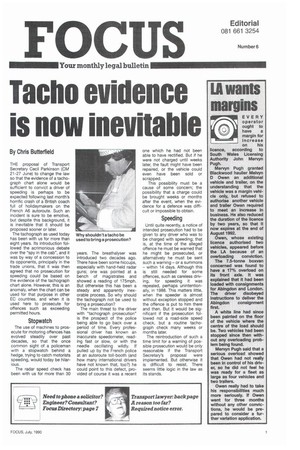Tacho evidence is now inevitable
Page 3

If you've noticed an error in this article please click here to report it so we can fix it.
THE proposal of Transport Secretary Cecil Parkinson (CM 21-27 June) to change the law so that the evidence of a tachograph chart alone would be sufficient to convict a driver of speeding is perhaps to be expected following last month's horrific crash of a British coach full of holidaymakers on the French A6 autoroute. Such an Incident is sure to be emotive, but despite this background, it is inevitable that it should be proposed sooner or later, The tachograph as used today has been with us for more than eight years. Its introduction followed the acrimonious debate over the "spy in the cab", and it was by way of a concession to its opponents, principally in the trade unions, that it was then agreed that no prosecution for speeding could be based on the evidence of the tachograph chart alone. However, this is an anomaly, when the chart can be used for that purpose in other EC countries, and when it is used here to prosecute for offences such as exceeding permitted hours.
The use of machines to prosecute for motoring offences has evolved steadily over past decades, so that the once common sight of a policeman with a stopwatch behind a hedge, trying to catch motorists speeding, would today be hilarious.
The radar speed check has been with us for more than 30 years. The breathalyser was introduced two decades ago. There have been some hiccups, especially with hand-held radar guns; one was pointed at a bench of magistrates and showed a reading of 175mph. But otherwise this has been a steady and apparently inexorable process. So why should the tachograph not be used to bring a prosecution?
The main threat to the driver with "tachograph prosecution" is the prospect of the police being able to go back over a period of time. Every professional driver has known an inaccurate speedometer, reading fast or slow, or with the needle oscillating wildly. If pulled up by the French police at an autoroute toll-booth (and how many international drivers have not known that, too?) he could point to this defect, provided of course it was a recent one which he had not been able to have rectified. But if he were not charged until weeks later, the fault might have been repaired, or the vehicle could even have been sold or scrapped.
This possibility must be a cause of some concern; the possibility that a charge could be brought weeks or months after the event, when the evidence for a defence was difficult or impossible to obtain.
Until quite recently, a notice of intended prosecution had to be given to any driver who was to be charged with speeding; that is, at the time of the alleged offence he must be warned that he might be prosecuted, or alternatively he must be sent such a warning or a summons within 14 days. Although this is still needed for some offences, such as careless driving, for speeding it was repealed, perhaps unintentionally, in 1988. This matters little. when the speeder is almost without exception stopped and the offence is put to him there and then. But it would be significant if the prosecution followed not a road-side speed check, but a routine tachograph check many weeks or months later.
The reintroduction of such a time limit for a warning of possible prosecution would be only reasonable if the Transport Secretary's proposal were implemented. But otherwise it is difficult to resist. There seems little logic in the law as its stands.




































































































